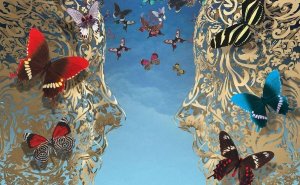Metaphor Therapy and the Language of Intuition

Metaphor therapy makes use of the poetic and literary language of stories and fables. Some ancestral cultures use metaphor therapy in one way or another to help their people develop emotionally.
Grandparents and shamans tell ancient, traditional stories to do so. However, most of them don’t narrate events that actually happened but symbolic episodes instead. The effect on these stories on those who listen to them is cathartic and mind opening.
“We all know that Art is not truth. Art is a lie that makes us realize truth at least the truth that is given us to understand. The artist must know the manner whereby to convince others of the truthfulness of his lies.”
-Pablo Picasso-
Metaphor therapy is used both in informal ways and as a part of formal psychological interventions. Stories, fables, and poetic language help open up the unconscious. Furthermore, they help bring repressed feelings, thoughts, and desires to the surface.
Metaphor therapy
Metaphors are figures of speech that consist of referring to one thing by mentioning another. Therefore, metaphors associate two realities that are related to each another in some way.
This makes it possible to substitute one for the other. For example, when someone says: “Heaven is crying,” they’re associating “crying” with “rain.” Depending on the context, this could be a way to describe a sad moment.

Stories, legends, fables, and poems are all metaphors. Although Little Red Riding Hood wasn’t a real girl, she’s the metaphorical representation of disobedient girls. On this note, fairies represent good fortune or divine intervention.
Stories leave their mark because whoever writes them lets their unconscious talk through them. Even if they do it consciously, metaphors emerge from the writer’s unconsciousness.
By the same token, stories capture the unconscious of those who hear them or read them. The interesting thing is that it has been proven that metaphors have the capacity to transform us internally.
Flexible thinking and metaphor therapy
Through the study of psychology, we know that metaphors help us assimilate reality from different perspectives. In other words, they make our view of the world more flexible.
Additionally, they also help us see our personal experiences from different angles and, therefore, find new solutions to old problems. Namely, this is the basis of metaphor therapy.
When we build or open our mind to metaphors, the “gears” in the right hemisphere of our brain begin to activate. This is a creative, intuitive, and global process. On the other hand, the left hemisphere is logical and rational, which is the side we tend to use the most.
Metaphors help us find outlets that we didn’t know existed. They help us see the world from many different perspectives to help us get out of our vicious cycles. This, in turn, promotes resilience.
A useful tool
Psychotherapists make frequent use of metaphors because they sow and suggest, not define and impose. They have a huge impact and help us modify our view of the world.

Stories have been used for healing since ancient times. They’re soothing to our soul because they gently awaken emotions that were dormant and allow us to see our emotional wounds from a more humane and peaceful perspective. Using metaphors also helps us deal with loneliness.
In conclusion, it’s a great idea to read and listen to stories, especially during difficult times, as literature and art offer help deal with discomfort and suffering.
This text is provided for informational purposes only and does not replace consultation with a professional. If in doubt, consult your specialist.








